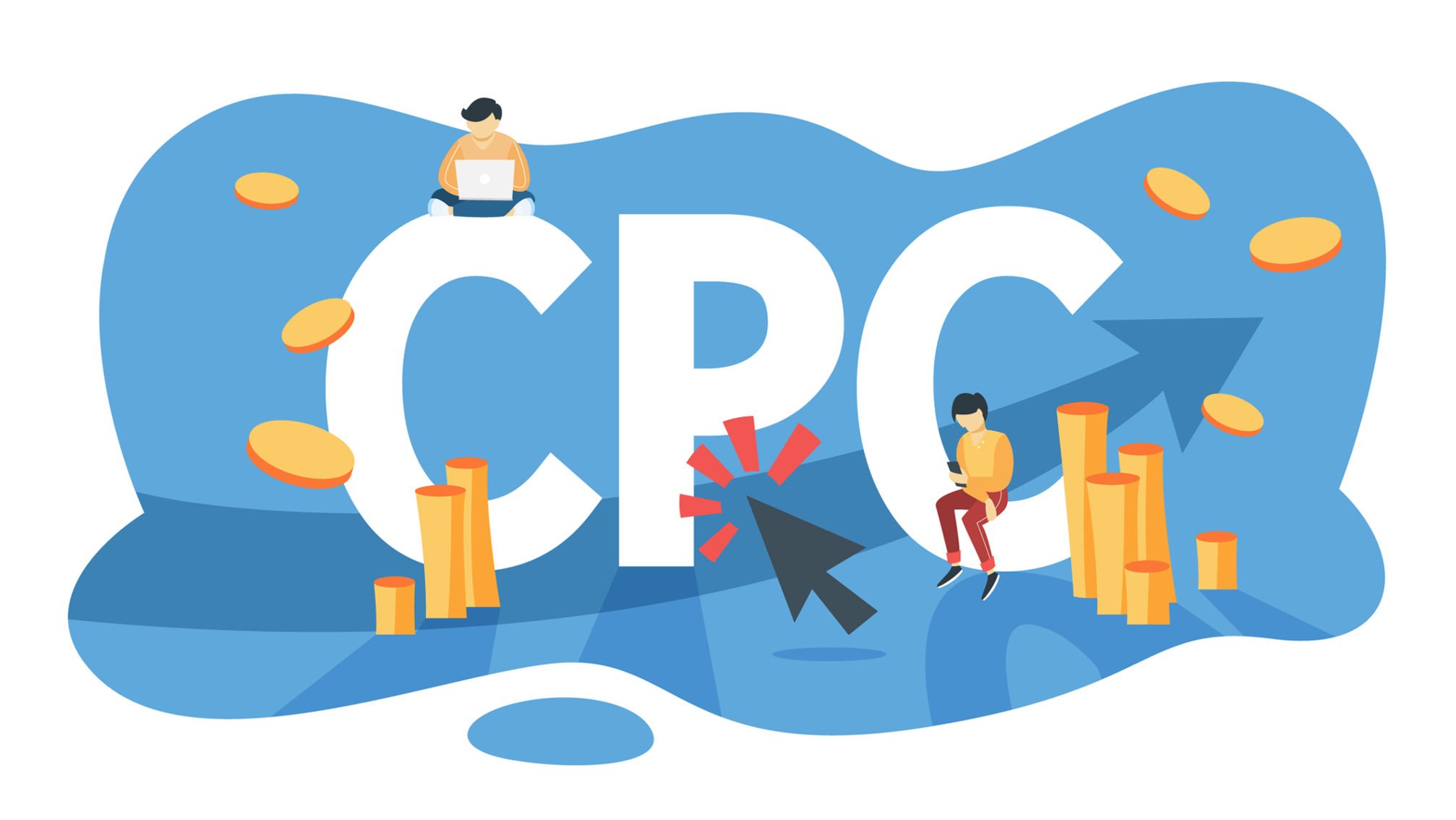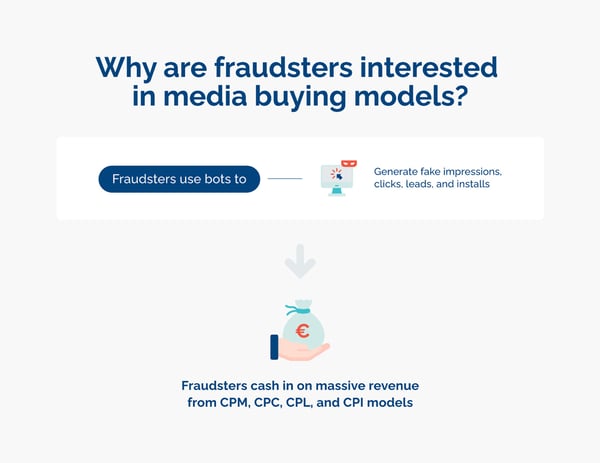Media Buying Models: How to Protect Them From Fraudsters

 By
Eduardo Aznar
·
5 minute read
By
Eduardo Aznar
·
5 minute read
When it comes to marketing campaigns, advertisers and marketers alike are keen to make their investment back with a good return on ad spend. In fact, they spent over $567 billion on digital advertising in 2022 to make this happen.
Opticks’ 2022 Ad Fraud Trends Report revealed that the priority for the majority of advertisers is generating more quality leads and online sales. And to help them achieve this objective, many advertisers and marketers look to performance-based media buying models such as Cost-Per-Mille, Cost-Per-Click, Cost-Per-Lead, and Cost-Per-Install.
However, with any ad campaign comes the potential for fraudsters to exploit it, no matter the compensation model. Here, we explain fraudsters’ interests in these models and what you can do to prevent them from targeting your campaigns.
- Media buying models explained: CPM, CPC, CPL & CPI
- Why are fraudsters interested in these models?
- How to stop fraudsters exploiting media buying models
- How Opticks can help
- Protect your campaigns no matter the media buying model
What media buying models are there? CPM, CPC, CPL & CPI explained
Fraudsters have a keen eye for identifying the most lucrative campaigns. Yet, there are some performance-based compensation models they target repeatedly due to how manipulable the campaigns are and their profitable payout terms.
Here’s a breakdown of how each media buying model works and why each is attractive to fraudsters.
Cost-per-mille (CPM)
Cost-Per-Mille (CPM) is a model in which an advertiser pays a flat rate when a thousand impressions are made on an ad.
In terms of ad fraud, the CPM model is attractive to fraudsters because of the predictable reward and the fact that they can quickly artificially inflate one thousand impressions on a piece of content.
Cost-per-click (CPC)
Cost-Per-Click (CPC) is a performance-based metric. Payments are made by advertisers every time a user clicks an ad.
Since the user does not need to complete the conversion for the click to be paid for, the CPC model is a popular target for fraudsters since they can easily mimic user interaction with ads. Both individuals and bots are used to perform repeated fraudulent clicks on targeted ads.
Cost-per-lead (CPL)
Cost-Per-Lead (CPL) is a model whereby payments are made once a user provides contact information such as an email address.
CPL fraud is performed by both people and bots and involves filling contact detail fields with fake information to trigger payment for the leads. Often, fraudsters will use stolen consumer data to fill out forms and sidestep honeypots (hidden forms that only bots can see).
Cost-per-install (CPI)
Cost-Per-Install (CPI) is a media buying model whereby an advertiser pays when a user downloads and installs an app. The CPI model is a quick way to drive installs, and fraudsters use bots and sometimes physical “install farms” made up of real people to manually install apps on countless devices.
Why are fraudsters interested in these media buying models?

Fraudsters’ number one goal is to make as much money as possible, as quickly as possible. Stealing money from your campaigns is almost always their main incentive. And they’re highly accomplished in using the various ad fraud techniques to do this -- in fact, ad fraud is predicted to cost businesses $120 billion in 2023.
The compensation models above are lucrative, and fraudsters exploit them on a daily basis using bots to generate fake impressions, clicks, leads, and installs, or by instigating fake accounts. Through these tactics, they’re able to generate an inordinate amount of revenue from CPM, CPC, CPL, and CPI models.
While some media buying models are easier to exploit than others (targeting CPC campaigns, for example, involves just clicking on ads to generate revenue), fraudsters are highly motivated to target all of the compensation models listed above.
The biggest ad fraud cases over the past few years demonstrate just how easily fraudsters can scale their operations to drain ad budgets quickly. One of the most well-known operations, Methbot, was generating between $3 and $5 million a day by executing fake clicks on video advertisements alone.
Here’s the bottom line: While one fraudster running a bot operation might be able to make thousands of dollars every week, a group of them running botnets and larger bot operations can steal millions. Sophisticated fraudsters know exactly how to follow the ad fraud money flow and cash in on each compensation model.
How to prevent fraudsters from exploiting media buying models
The only way to stop fraudsters from exploiting these media buying models and protect your advertising and marketing spend is by implementing ad fraud prevention measures from the get-go.
Manual and semi-manual ad fraud prevention methods
Advertisers and marketers can use manual reviews to detect and prevent fraud. This involves carefully reviewing all impressions, clicks, leads, and installs to ensure they derive from real users.
For example, some organizations choose to engage in IP blocking, also known as blacklisting. This involves restricting certain IP addresses and servers from accessing websites and, consequently, their ads. This can be done manually, while other organizations choose to maintain their own blacklists to prevent clicks, impressions, installs, and leads from undesirable sources.
However, this method does not offer the adaptability required to counteract fraudsters' sophisticated techniques. Blacklisting is not robust enough to help organizations analyze traffic effectively, nor can it eliminate false positives.
Verification methods
Organizations can also use verification methods to prevent fraudsters from exploiting performance-based models. Such methods include requiring IP address verification, device identification, and geolocation to ensure that real users are engaging with their content.
However, this is also not a holistic ad fraud prevention method. There is no guarantee that organizations can redeem false positives and fraudsters can easily evade verification measures.
Robust anti-ad fraud solutions
Since fraudsters can easily sidestep manual and verification methods, organizations need a solid and dedicated anti-ad fraud solution to help them prevent ad fraud before it becomes a problem.
Anti-bot and anti-fraud solutions are bolstered by state-of-the-art technology that helps both detect ad fraud and prevent bot-generated traffic from damaging your campaigns.
💡 Read more: What are the top ad fraud prevention companies?
How Opticks can help
Opticks, the most advanced invalid traffic detection, protection, and intelligence software, uses proprietary machine learning algorithms to prevent fraudulent activity across all types of media buying models.
Here’s a breakdown of how Opticks protects organizations’ campaigns across each compensation model:
- CPM fraud prevention: Opticks detects and prevents CPM fraud by analyzing the traffic generated by publishers to ensure it is legitimate. Opticks also detects the use of bots and other automated traffic-generating techniques that can artificially inflate CPM rates.
- CPC fraud prevention: Opticks helps prevent CPC fraud by analyzing click data to ensure that the clicks derive from legitimate sources. Opticks detects the use of click bots or click farms that generate large volumes of clicks without the correct corresponding engagement, ensuring that advertisers are only charged for legitimate clicks.
- CPL fraud prevention: Opticks helps prevent CPL fraud by analyzing lead data to ensure that leads are legitimate and of high quality. Opticks detects fraudulent leads generated by bots or by incentivized users who may provide false information in order to receive a reward.
- CPI fraud prevention: Opticks helps prevent CPI fraud by analyzing traffic before it leads to app installs and in-app events to ensure that they’re legitimate. Opticks detects invalid traffic generated by bots or by incentivized users who install apps only to receive a reward, without any intention of using the app or making in-app purchases.
These are just a few examples of how Opticks can help prevent ad fraud across different media buying models. Through the use of machine learning algorithms and sophisticated fraud detection techniques, Opticks helps advertisers identify and prevent fraudulent activity, therefore protecting their ad spend and ensuring that their campaigns generate maximum ROAS.
Protect your campaigns from day one -- no matter the media buying models
As a low-risk and high-reward activity, fraudsters are always on the hunt for ways to exploit performance-based models such as CPM, CPC, CPL, and CPI.
No matter which compensation model you employ, if fraudsters manage to capitalize on your campaigns, the outcome is the same: your ad campaigns are ruined, your budgets are depleted, and your data is flawed.
The only safe way that advertisers and marketers can protect their campaigns against ad fraud is by prioritizing proactive ad fraud prevention -- and this involves a robust and dedicated anti-ad fraud solution.
Opticks is a cross-channel and full-funnel anti-ad fraud solution that detects and prevents ad fraud across all media buying models. Our holistic solution is dedicated to preventing ad fraud from the outset, helping advertisers and marketers protect themselves against fraudsters exploiting all types of performance-based models.
To learn more about how the expert team at Opticks can protect your ad campaigns by preventing ad fraud before it can even cross your radar, contact us today.
